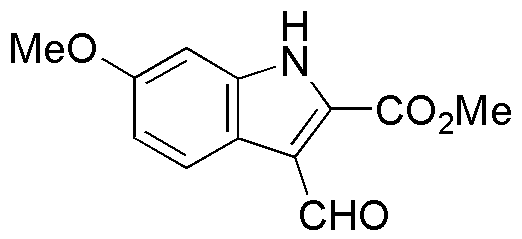Methyl 3-Formyl-6-methoxy-1H-indole-2-carboxylate is widely utilized in research focused on:
- Pharmaceutical Development: This compound serves as a key intermediate in synthesizing various pharmaceutical agents, particularly in developing anti-cancer and anti-inflammatory drugs.
- Natural Product Synthesis: It is used in the synthesis of natural products, allowing researchers to create compounds that mimic the structure and function of biologically active molecules found in nature.
- Organic Synthesis: The compound is valuable in organic chemistry for creating complex molecules through various reactions, enhancing the toolkit available to chemists in both academia and industry.
- Material Science: It finds applications in developing new materials, such as polymers and coatings, that require specific chemical properties for improved performance and durability.
- Biological Research: Researchers utilize this compound to study its interactions with biological systems, helping to uncover mechanisms of action and potential therapeutic targets.
General Information
Properties
Safety and Regulations
Applications
Methyl 3-Formyl-6-methoxy-1H-indole-2-carboxylate is widely utilized in research focused on:
- Pharmaceutical Development: This compound serves as a key intermediate in synthesizing various pharmaceutical agents, particularly in developing anti-cancer and anti-inflammatory drugs.
- Natural Product Synthesis: It is used in the synthesis of natural products, allowing researchers to create compounds that mimic the structure and function of biologically active molecules found in nature.
- Organic Synthesis: The compound is valuable in organic chemistry for creating complex molecules through various reactions, enhancing the toolkit available to chemists in both academia and industry.
- Material Science: It finds applications in developing new materials, such as polymers and coatings, that require specific chemical properties for improved performance and durability.
- Biological Research: Researchers utilize this compound to study its interactions with biological systems, helping to uncover mechanisms of action and potential therapeutic targets.
Documents
Safety Data Sheets (SDS)
The SDS provides comprehensive safety information on handling, storage, and disposal of the product.
Product Specification (PS)
The PS provides a comprehensive breakdown of the product’s properties, including chemical composition, physical state, purity, and storage requirements. It also details acceptable quality ranges and the product's intended applications.
Certificates of Analysis (COA)
Search for Certificates of Analysis (COA) by entering the products Lot Number. Lot and Batch Numbers can be found on a product’s label following the words ‘Lot’ or ‘Batch’.
*Catalog Number
*Lot Number
Certificates Of Origin (COO)
This COO confirms the country where the product was manufactured, and also details the materials and components used in it and whether it is derived from natural, synthetic, or other specific sources. This certificate may be required for customs, trade, and regulatory compliance.
*Catalog Number
*Lot Number
Safety Data Sheets (SDS)
The SDS provides comprehensive safety information on handling, storage, and disposal of the product.
DownloadProduct Specification (PS)
The PS provides a comprehensive breakdown of the product’s properties, including chemical composition, physical state, purity, and storage requirements. It also details acceptable quality ranges and the product's intended applications.
DownloadCertificates of Analysis (COA)
Search for Certificates of Analysis (COA) by entering the products Lot Number. Lot and Batch Numbers can be found on a product’s label following the words ‘Lot’ or ‘Batch’.
*Catalog Number
*Lot Number
Certificates Of Origin (COO)
This COO confirms the country where the product was manufactured, and also details the materials and components used in it and whether it is derived from natural, synthetic, or other specific sources. This certificate may be required for customs, trade, and regulatory compliance.


